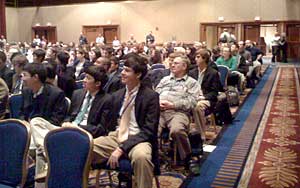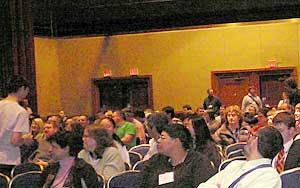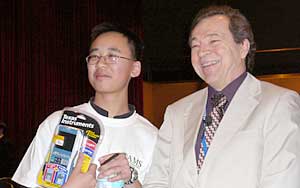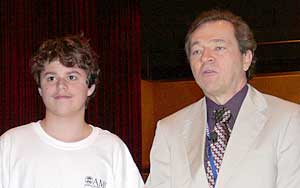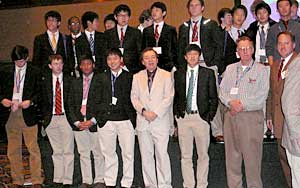
Who Wants to Be a Mathematician at the 2009 Joint Mathematics Meetings in Washington, DC
|
|
"The Who Wants to be a Mathematician contest was a wonderful opportunity for Alex and for our school. We appreciate the chance to celebrate math and challenge ourselves."
"Thank you for offering this opportunity for our kids. We had a wonderful time, and everyone thoroughly enjoyed themselves."
"The kids had a FABULOUS time both at WWTBAM and at the rest of the day's sessions and in the exhibit hall, etc."
"Thanks for the opportunity to participate. I've gotten a lot of mileage out of the experience in speaking with other teachers, the school communications office, etc. It's a great idea and the format really intrigues people. I hope that you can continue it in future years."
|
|
A standing-room only crowd of 500 students, teachers, and Joint Mathematics Meetings attendees saw Linus Hamilton, a 9th grader at Eleanor Roosevelt High School, win US$3000 in Who Wants to Be a Mathematician at the Marriott Wardman Park Hotel in Washington, DC. The group of eight contestants from Maryland, Virginia, and Washington, DC (pictured and listed below), was the youngest group ever, with one freshman, three sophomores, a junior, and three seniors.
|
(left to right)
- Akshar Wunnava, Thomas Jefferson High School for Science and Technology (VA)
- Alexander Zhu, Poolesville High School (MD)
- Rachel Zhang, Walt Whitman High School (MD)
- Rachel Coston, Potomac Falls High School (VA)
- Mike Breen, American Mathematical Society Public Awareness Officer, and game emcee (RI)
- Alex Golden, Springbrook High School (MD)
- Michael Lindsey, St. Albans School (DC)
- Linus Hamilton, Eleanor Roosevelt High School (MD)
- Siyun Lai, Washington-Lee High School (VA)
|
Akshar and Alexander were very close throughout game one, but Alexander pulled out the victory on the last question. Both contestants missed only one question, but the question Alexander missed was worth fewer points than the one Akshar missed. The victory earned Alexander a TI-Nspire graphing calculator, from Texas Instruments, $500 from the AMS, and a spot in the Square-Off Round against the game two winner for a chance at another $2500. (At left, front row: Alex Golden, Akshar Wunnava; second row: Rachel Zhang, Alexander Zhu.) | |
|
In game two, Akshar became the helper for Siyun Lai and got into the action very early as Siyun used his Help on the second question. Akshar confirmed what Siyun thought was the correct answer (and in fact, was). Two other contestants also used their Help in this game: Rachel, who used hers on the sixth question and her helper responded, "Why didn't you call on me earlier?" (when he was more confident of his answer), and Michael, who used his on the seventh question when a St. Albans' classmate gave him excellent advice. The only game two contestant who didn't use his Help apparently didn't need it as Linus missed just one question and won the game (winning the same prizes and amount of cash that Alexander won in game one). (Front: Rachel Coston, Linus Hamilton; Second Row: Siyun Lai, Michael Lindsey.) |
|
So it was a freshman (Linus) versus a sophomore (Alexander) in the Square-Off Round. Linus did some frantic calculations and was the first to signal in and answer the question correctly. Alexander later revealed that he also saw how to do the problem, but not as fast as Linus did. Answering the question correctly first earned Linus another $500 and a trip to the Bonus Round. | |
|
In the Bonus Round, one question worth $2000, Linus calculated almost as fast as he had in the Square-Off Round, but for this question he had a lot more time to work with--three minutes--which gave him plenty of time to check his work.
|
Just to make it interesting, and to show that he has a playful streak, Linus scrambled for the signaling device as time expired, but he really had no intention of changing his answer. It turned out that the audience agreed with Linus's choice, and appreciated his great explanation of why he thought the choice was correct. Sure enough, it was correct, so Linus walked away (presumably to a vehicle, since he had to get back to Maryland) with a total of $3000. |
|
|
Here are the prizes won by the eight contestants:
- TI-Nspire graphing calculator from Texas Instruments, and $3000 from the AMS: Linus Hamilton
- TI-Nspire graphing calculator from Texas Instruments and $500 from the AMS: Alexander Zhu
- Maple 12 from Maplesoft: Akshar Wunnava and Siyun Lai
- Calculus with Early Transcendentals by Anton, Bivens and Davis from John Wiley and Sons: Alex Golden and Rachel Coston
- What's Happening in the Mathematical Sciences from the AMS: Rachel Zhang and Michael Lindsey
Thanks to the sponsors Texas Instruments, Maplesoft, and John Wiley and Sons, for their continued support of Who Wants to Be a Mathematician, and to all the teachers who participated in the contest.
|
Photographs by Who Wants to Be a Mathematician judge and co-creator Bill Butterworth (DePaul University Department of Mathematical Sciences), AMS Public Awareness Officer Annette Emerson, Notices Managing Editor Sandy Frost, and Mike Breen.
More on the 2009 Joint Mathematics Meetings.
Find out more about Who Wants to Be a Mathematician.




